SITE IS UNDER DEVELOPMENT
please send your suggestions to
[email protected]
SIMILIPAL BIOSPHERE RESERVE
RESEARCH
Part-2
Home -
(go to:Contents)---
view books
CONTENTS
Part-1
(go to: Research:PART-1)
Part-2
4.SIGNIFICANT RESEARCH CONTRIBUTIONS
4.1.Important Surveys
4.1.1.Mugger Survey
4.1.2.Avian Surveys
4.1.3.Floristic Surveys
4.2.Management of Endangered Species
4.2.1.Study of Mugger
4.2.2.Study of Tiger
4.2.3.Study of elephants
4.2.4.Species-Oriented Research
4.2.4.1.Giant squirrel
4.2.4.2.Black headed Munia
4.3.Socio-economic Studies
4.4.Development of Techniques
4.4.1.Tiger and Leopard Census
4.4.2.Large Herbivore Census
4.4.3.Crocodile studies
4.4.4.Chemical capture
4.4.5.Saltlick maintenance
4.4.6.Habitat manipulation
4.5.Habitat and Indicator fauna Management
4.6.Tourism Pattern and Conservation education
4.7.Development of Database
5.RESEARCH IN THE PERIPHERY
6.BIOSPHERE RESERVE AND RESEARCH
7.RESEARCH PRIORITIES
8.SUMMARY
Part-3(go to: Research:PART-3)
9.PUBLICATIONS
(go to:Contents)
PART-2
4.SIGNIFICANT RESEARCH CONTRIBUTIONS
Sagar and Singh (1993a) summarised the research in Similipal Tiger Reserve from the year 1973 to 1993. State-of-the-art reports are available for Similipal from Patro and Misra (1985), while Dani et al (1991) presented an overview of research at the crocodile project, Ramatirtha under Similipal Tiger Reserve. The following account is about the significant research contributions from the beginning of the Project Tiger in 1979.
go to:Contents
4.1.Important Surveys
go to:Contents
4.1.1.Mugger Survey
Based on the results of a preliminary survey of their status, country's first crocodilian management projects were started in Orissa. Later, status surveys were undertaken for the mugger (Crocodylus palustris) in Similipal and it was indicated that the mugger was extinct in Similipal by the year 1979. Monitoring have highlighted a positive trend of growth of populations of mugger in Similipal but because of continued human pressure on wetlands muggers have not done as well as it should be expected. These studies are significant when voices are raised about commercial utilisation of the crocodilian resources under an assumed plea that the group is safe in the wild.
go to:Contents
4.1.2.Avian Surveys
Important Avian Surveys have been carried out by U.N. Dev under an Eastern Ghat Project- "Project Bihang", and by teams from the Bombay Natural History Society. In association with ornithologists from the BNHS and the U.S. Fish and Wildlife Service a checklist of raptors of Similipal has also been prepared. Similipal is one of the few areas where avian surveys have been of fairly good order. Over 450 spp. of birds have been identified for Orissa. Of these 242 have been recorded in Similipal. A study on the wetland birds in the periphery of Similipal has also been taken up. Two reservoirs, namely Badajora and Haladia attract winter birds which also breed there, particularly in Badajora. These two habitats promise for development as good bird-watching sites close to the district headquarters of Baripada in the outskirts of Similipal.
go to:Contents

4.1.3.Floristic Surveys
A Systematic survey over five years by a team from Regional Research Laboratory, Bhubaneswar led by Saxena and Brahmam, 1989 recorded 1076 spp. of plants for the Similipal hills. There are only two species of Gymnosperm and 60 species of ferns. The dicotyledonous:monocotyledonous species % ratio is (71.5:28.5) for Similipal as against (68.9):(31.1) for Orissa and (81.3):(18.7) in the world flora. The higher percentage of monocotyledonous spp. for Similipal is due to higher number of grasses. There are 150 spp. of grasses in families Poaceae (=Graminacea): 107 spp. and Cyperaceae: 43 spp. During winter, 1993-94 two professors from the Botany Department of Marathwada University have located the grass Coix aquatica near Ransa in Similipal. Earlier the species was recorded outside the Tiger Reserve. In Similipal 92 species of orchids under 36 genera have been recorded by Mishra, 1989. These figures are against 124 spp. known for Orissa. The Orchid flora includes 20 spp. of Himalayan elements, 2 spp. of south India and 10 spp. common to the north and south.
go to:Contents
4.2.Management of Endangered Species
4.2.1.Study of Mugger
Important studies on Crocodylus palustris have generated or supplemented data on biology, growth variations, and territorial resource partitioning with implication in sanctuary management. Although muggers may peacefully coexist with man and cattle, there are recommendations to consider the territorial habits of the species in order to mitigate man-crocodile conflicts. Annual monitoring of crocodile populations have been carried out to assess the growth and survival of released muggers in Similipal and plan the future strategy with the species.
go to:Contents
4.2.2.Study of Tiger

Based on observations made on a free-living pet tigress, Khairi, several aspects of reproductive biology, senses and inter-specific interactions of tiger have been recorded. During the same period Mr. R.L. Brahamachary studied the marking fluids of Khairi for chemical description of the pheromones. The study was later pursued on tigers at Nandankanan.
During 1989-93 repeated surveys on Tiger population have led to inferences on the biology and population dynamics of tiger and leopard in the wild in Similipal. Polygamy is more pronounced in tiger when compared with leopard. The sex ratio may be 1:1 at birth but it favours females in the prime breeding territories. About 12% of female tigers litter every year and 72.2% of cubs belong to tigresses with hind pugmark lengths 12-13.9 cm. Young tigers with pug lengths 9.0-10.9cm remain away from main territories while trying to set their own territories.

An analysis of the records of tigers with aberrant colours- white, black etc. have suggested that aberrant colours with 'no stripes' to 'completely black' tigers with intermediary stages of various shades of white tigers, the pallid or golden tiger, various shades of normal yellow tiger, the brown tigers, the melanistic tiger and the blue tigers occur according to a normal distribution curve in the wild gene pool of Panthera tigris. The dome is occupied by different shades of 'normal colour' tigers, while the aberrants occupy various regions of the dome of the curve. The aberrants reappear in a population in normal course of time as throw-backs and not because of identical repetitions of mutations. We just do not see these often because sighting a normal tiger is a rare event by itself. The biological and conservation implications of colour variations have also been analysed. A compedium of publications has been released from Similipal Tiger Reserve, and a preliminary reference document on implications of colour aberration in tiger has been prepared by one of us with assistance from WWF-India.
Population trends studied in Similipal during 1989 to 1995 showed that the tiger population had been stable though human population had increased by 40%. Hence, it was feared that there may be a population crash for the tiger. These observations have further been substantiated during 1997 with more results coming in from population monitoring. These studies have far reaching implications to support appropriate decision about reducing human pressure through village relocation if tiger is to be prevented from an imminent extinction at the present level of management input and the rate of growth of human population, hence human pressure inside the tiger reserve.
Habitat utilisation by tiger has been studied round-the-year which highlight the dynamics of habitat-sharing by tigers and leopards of either sex.
go to:Contents
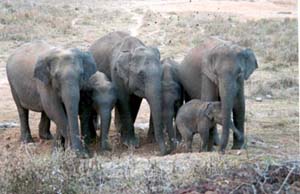
4.2.3.Study of elephants
Important studies are on the identification of elephant habitats including corridors, the distribution pattern, population status and management issues relating to elephants of Orissa. Another study involved the analysis of the sighting trends of elephants in Similipal during nine years. These studies led to planning of the Project Elephant for Orissa. Also, these studies led to decisions about elephant census season, tourism zone and tourism season in respect of Similipal Sanctuary and National Park. Besides, the 'sighting trend' highlighted aspects relating to population biology of the elephant in Similipal. There has been a significant analysis of male-male aggressions among elephants leading to natural deaths.go to:Contents
4.2.4.Species-Oriented Research
4.2.4.1.Giant squirrel
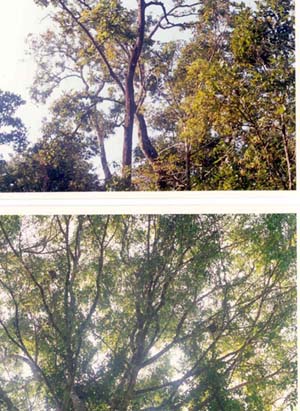 A preliminary study on Ratufa indica was conducted which highlighted the distribution pattern of the species indicating the quality of forest canopy. Besides, twenty one food plants were identified. The food plants are: Shorea robusta (Sal), Terminalia tomentosa (Asan), Anthocephalus cadamba (Kadamba), Bursera serrata (Rimeli), Carreya arborea (Kumbhi), Dillenia pentagyna (Rai), Schelichera trijuga (Kusuma), Michelia champaca (Champa), Terminalia belerica (Bahada), Terminalia chebula (Harida), Syzygium cumini (Jamu), Eugenia operculata (Poi jamu), Mangifera indica (Amba), Adina cordifolia (Kuruma), Bredelia ratusa (Kasi), Gmelina arborea (Gambhari), Anogeissus latifolia (Dhaura), Cassia fistula(Sunari), Emblica officinalis (Anla), Tamarindus indica (Tentuli), and Buchanania lanzan (Chara). Parts which are fed upon include bud, flower, fruit, leaf and petioles. Mango and Rimeli appear to be used for gnawing.
go to:Contents
A preliminary study on Ratufa indica was conducted which highlighted the distribution pattern of the species indicating the quality of forest canopy. Besides, twenty one food plants were identified. The food plants are: Shorea robusta (Sal), Terminalia tomentosa (Asan), Anthocephalus cadamba (Kadamba), Bursera serrata (Rimeli), Carreya arborea (Kumbhi), Dillenia pentagyna (Rai), Schelichera trijuga (Kusuma), Michelia champaca (Champa), Terminalia belerica (Bahada), Terminalia chebula (Harida), Syzygium cumini (Jamu), Eugenia operculata (Poi jamu), Mangifera indica (Amba), Adina cordifolia (Kuruma), Bredelia ratusa (Kasi), Gmelina arborea (Gambhari), Anogeissus latifolia (Dhaura), Cassia fistula(Sunari), Emblica officinalis (Anla), Tamarindus indica (Tentuli), and Buchanania lanzan (Chara). Parts which are fed upon include bud, flower, fruit, leaf and petioles. Mango and Rimeli appear to be used for gnawing.
go to:Contents
4.2.4.2.Black headed Munia
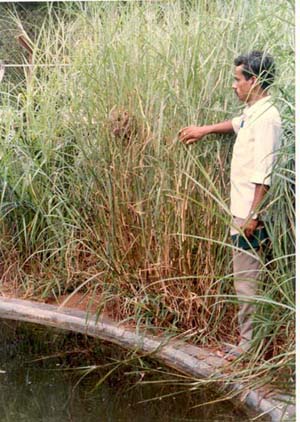
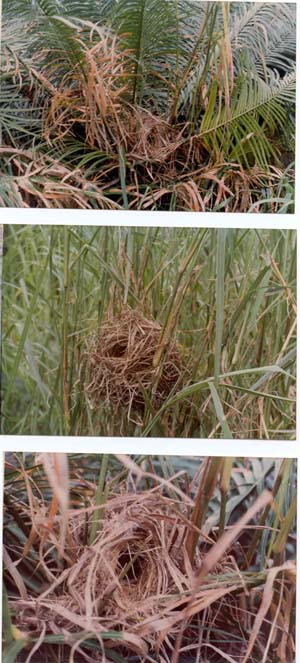
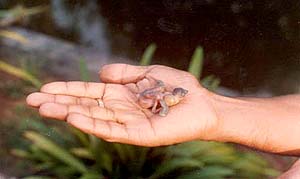
After reporting about the range extension for Lonchura malacca malacca to east of its formerly cited limit in Raipur, a study on the nesting biology of the species was undertaken at Ramatirtha near Jashipur. The birds nest every year in the vegetations in the crocodile pens at Ramatirtha. Apart from nesting ecology of L. m. malacca, the study highlights multiple use of an exhibit and methods for environmental enrichment in captive management of crocodiles.
go to:Contents
4.3.Socio-economic Studies

The involvement of local people in the operation of the crocodile project and the benefits accrued to the public is well known. As a prelude to the launching of Eco-development scheme for Similipal Tiger Reserve pilot studies were taken up to assess the people's economic status and level of dependency on forests. Similarly, for preparation of the management plan for the Similipal Biosphere Reserve socio-economic studies were also taken up in some sample villages in the area covered under the biosphere reserve.
There are over 1200 villages within 10km from the boundary of the Tiger Reserve which exert tremendous pressure for fodder, fuel and MFP etc. Socio-economic surveys have been conducted in 52 villages. The surveys were conducted at different times through different agencies, and Ecodevelopment activities are taken up or being planned under three separate schemes. These are:- (1) Global environmental facility of World Bank, (2) Centrally sponsored plan of Similipal Tiger Reserve, and (3) World Food programme.
Various aspects addressed through the scheme are under (a) improved protected area management, (b) programme to reduce negative impact of local people on biodiversity, and (c) ecological and human research and education.
go to:Contents
4.4.Development of Techniques
4.4.1.Tiger and Leopard Census
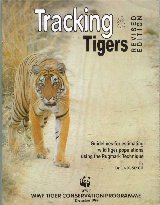

Annual censuses were conducted in Similipal Tiger Reserve and certain perfections and changes were made to the previous approach. Census season has been changed to winter (December/January) because of the absence of a pinch period related to water in Similipal. The census units, routes and the numbers of pad impression pads (PIPs) in each route have been standardised. Tracks of adult leopard and tiger cubs are distinguished from the strides apart from features of pugmarks. The strides are about ten times the hind pugmark length for tiger cubs but about thirteen to fourteen times for adult leopards. The difference in the length and breadth of hind pugmark is less than 1.5cm for adult male tigers. The significance and reliability of the pugmark technique has been emphasised time and again, and it is the only economic method applicable on an all-India basis.
go to:Contents
4.4.2.Large Herbivore Census
Different approaches have been made for estimation of different herbivores. The methods used were thus: (1) short-duration sample count (transect census) for langur and rhesus macaque in winter along with tiger census; (2) long-duration sample count (transect census) for wild dog, bear, bison, sambar, chital, barking deer, mouse deer and wild boar; and (3) prey-biomass count (supported with data from carnivore census and sample count of herbivores). Elephant census has been conducted in recent years during 1989 and 1994. Now that all the procedures are laid down in writing, these can be repeated to assess the population trends.
go to:Contents
4.4.3.Crocodile studies
Capture techniques for mugger from the wild have been developed and tested in river Khairi-Bhandan. Captive breeding of crocodiles have been improved by providing Vit-E treatment.
go to:Contents
4.4.4.Chemical capture
Chemical capture of a wild leopard from Baripada has enabled to determine dosages of Ketamine Hydrochloride to be administered and precautions to be taken during its translocation and release back in the wild. On another occasion a problem elephant was immobilised with Etorphine Hydrochloride and captured from Bolangir to solve an 18-years old elephant-man conflict. These captures have application in management of man-wildlife interactions.
go to:Contents
4.4.5.Saltlick maintenance

Dosages have been fixed for the application of common salt and rock salt at the saltlicks in order to standardise maintenance of such sites for supplementary feeding. From studies conducted during 1993-94 and 1994-95 it has been determined that under local conditions treatment of application of 2% salt mixture in the saltlicks will be an ideal safe dose of use. The salt mixture for treatment consist of 1part of rock salt and 5 parts of common salt, both mixed in powder form. The quantity of salt-mixture is 2% by volume of earth filled-in. The salt mixture is thoroughly mixed with the earth.go to:Contents
4.4.6.Habitat manipulation
Two major practices of habitat manipulation studies have been carried out. One is to create vegetation plots at sites where unpalatable grasses have established and the other is to develop meadows by checking the invasion of forest growth. Data suggest that small mammals and large birds use the vegetation plots since early part of the fire-season. Places where meadows have been restored sighting of herbivores have increased to indicate enhanced use of such meadows. Similipal is subjected to invasion of tree growth into the meadows.
go to:Contents
4.5.Habitat and Indicator fauna Management
Management Action Plans have been prepared for the Similipal Tiger Reserve in 1973 and 1986. A fresh document is being planned for the tiger reserve. In adjunct to it, a management plan for the elephants and their habitats have also been prepared. The concept ensures management of all isolated populations and fragmented habitats of elephants around Similipal. With the adoption of the concept of 'Biosphere Reserve' the human dimensions too are taken care of under the fresh plans of 'Ecodevelopment' and "Biosphere Reserve'.
go to:Contents
4.6.Tourism Pattern and Conservation education
 tourism research.powerpoint show
tourism research.powerpoint show
Similipal Tiger Reserve attracted 24,413 tourists in 1996-98. The number has increased from about 6,000 in the year 1980-81. During the last five seasons an average of 20,037 tourists visited Similipal Tiger Reserve. Based on research findings tourism routes and tourism seasons have been introduced. A study on analysis of tourism pattern was commenced from 1993. The data indicate on the sources of Indian and overseas tourists, the profile of the tourists, the type and sources of transport, and several other related parameters. These information have aided in tourism management.
About 92% tourists hire vehicles from the open market to visit the Reserve. The tourists spend most of their time with the drivers. Therefore, orientation trainings for such drivers and their owners are being conducted since 1993 prior to the commencement of the tourism season with the basic objective to make a trip interesting, safe and memorable. Feedbacks received from the participants are analysed to improve tourism management.go to:Contents

Similarly, nature camps have been arranged from 1993 for various groups of participants in the age group 13 to 48 years. The objective has been to impart conservation education through trekking, visits to management areas and tourism spots, animal sightings, interpretation of animal evidences, and discussion on basics of management approach. Feedbacks from the participants have been analysed to improve approaches in conservation education.
go to:Contents
4.7.Development of Database
Similipal Tiger Reserve and Nandankanan Biological Park have been the coordinating agency for operations of all-Orissa Tiger Census. During these operations preliminary information have been collected on availability of some easily noticeable species of ildlife. Similarly, data are available on the occurrence of man-wildlife conflicts. The collection of data on maximum-minimum temperature, relative humidity and rainfall have been an intimate part of the project. These data have guided in day-to-day management decisions and in interpretation of research data.
Computer facilities have developed at the headquarters of Similipal Tiger Reserve. With future expansion of the facilities it is expected that a better network of computerised database will emerge for the state. At present the facility at Similipal is used for analysis of data from research and census, and the preparation of reports and papers. The use of the facility for general management is on the increase.
go to:Contents
5.RESEARCH IN THE PERIPHERY
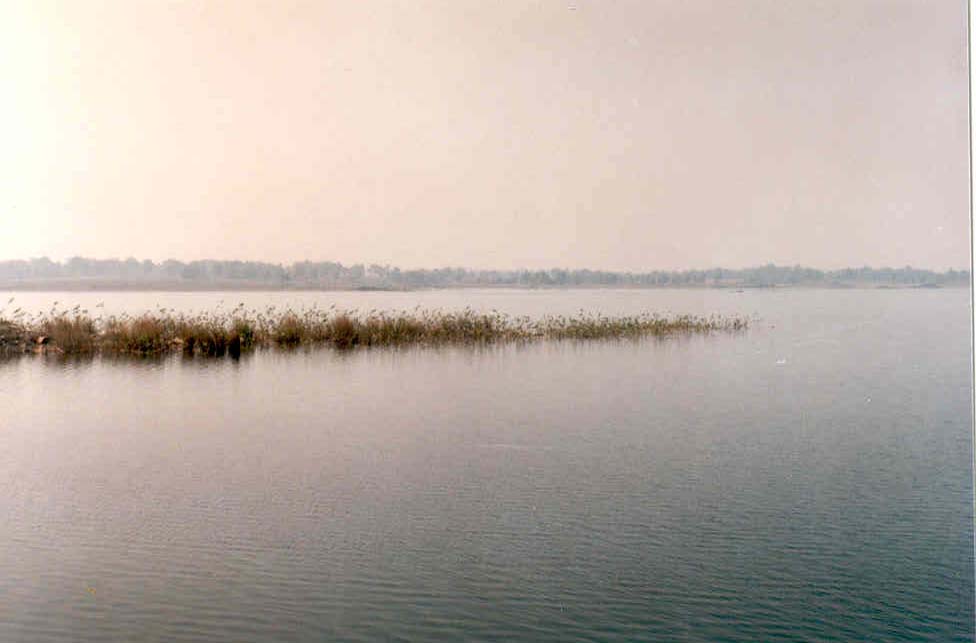

(1) In order to highlight the significance which Similipal may be bearing on the microclimate in its periphery, the avi-fauna potentiality of two wetland areas were studied from October 1995. These two areas are Badajora and Haladia. Both these areas are reservoirs and about 20km away from Baripada. Badajora is in the south and Haladia in the north of Baripada.
A preliminary checklist of birds with notes on their abundance and local human dimensions have been prepared, and a long-term study of avifauna/migratory birds in the wetlands peripheral to Similipal is being proposed.
(2) Another preliminary study has also been conducted on the environmental impact assessment of china clay mines in the periphery of Similipal. The data were under analysis at the time of preparation of this write-up.
go to:Contents
6.BIOSPHERE RESERVE AND RESEARCH
The state of Orissa is covered with 57183sq. km. of forest area out of which about 12.65% are covered under a network of two National parks and 17 sanctuaries. Similipal contributes 38% area for the total area of PA-network in Orissa.
The Similipal Biosphere Reserve comprises of the entire Similipal Sanctuary and proposed National Park, Nato and Satkosia reserved forest and a belt of l0 km from the boundaries of Similipal.
For the Biosphere Reserve it is proposed to conduct research on the following subjects.
(A) Status of biodiversity, meteorological information and abiotic components like soil and water. Survey will be conducted through agencies like ZSI, BSI and Universities etc. in buffer and transitional zone for updation of checklist of fauna and flora. Meteorological stations will also be established to monitor the weather data in the peripheral area.
(B) Habitat utilisation by wild animals: Study will be conducted to ascertain the pattern of habitat use, intra-specific, inter-specific- and also seasonal-use. This study will also help to ascertain the choice and preferences of the various animals for different species of plants in the buffer and transitional zone.
(C) Changes in socio-economic status.
(D) Monitoring of utilities of protection action.
(E) Impact assessment and monitoring research: These will be used as indicator performance for conservation components, eco-restoration activities and eco-development. The cost of such research programme has been in-built in various management activities of the Biosphere Reserve.go to:Contents
7.RESEARCH PRIORITIES
The scope for research inside Similipal and its periphery is vast, but a modest list of broad priorities is given below. This follows a national pattern set by the Wildlife Institute of India.
Wildlife of Ecosystems and regions
- Forest:
Corridors, frost-affected areas.
- Fresh water:
Rivers from Similipal.
Wildlife Species and Communities
Detailed studies on status, ecology and management of the following.
- Rare and endangered in the state:
Mahasheer, Chameleon, Hornbill, Black-headed Munia,
Wilddog, Pangolin, Chowsingha, Mouse deer.
- Indicators:
Freshwater turtles, land tortoise, raptors,
wetland birds in the periphery of Similipal,
giant squirrel, flying squirrel, orchids.
Technique and Methodologies
- checklists of important flora and fauna,
assessment of impact of other projects of the Govt.,
threats and management requirements.
(Development of management strategy/plans)
- Census and population trends.
(of 'flag-ship species' like tiger, elephant and
crocodiles and other important fauna).
- Captive breeding of mugger crocodiles
People's need and involvement
- Development of Eco-Development Schemes
- Conflicts and control.
- Conservation Education.
Other activities
-Database Management.
-Research Coordination.
-Information dissemination (workshop, trainings).
go to:Contents
8.SUMMARY
Similipal is an interesting and unique place for ecological and wildlife studies because of its biogeographical situation, geological features and an international recognition as one of the first nine prime areas for tiger conservation. The founder-Field Director late S. R. Choudhury conducted certain biological and management oriented studies. The project tiger and the crocodile project are the main producers of research data. Studies pursued by outsiders are largely not available at the project tiger headquarters. However, the trend of research include (1) Important Surveys on mugger crocodiles, the avian composition and floral richness, particularly the orchidaceous flora. Studies relating to the management of endangered species include those on the mugger, tiger and elephants. The tiger study covers the much publicised studies on the Khairi tigress. It has been found out that aberrant colours with 'no stripes' to 'completely black' tigers with intermediary stages of various shades of white tigers, the pallid or golden tiger, various shades of normal yellow tiger, the brown tigers, the melanistic tiger and the blue tigers occur according to a normal distribution curve in the wild gene pool of Panthera tigris. Species-Oriented Research include preliminary studies on the Giant squirrel and Black headed Munia. Socio-economic Studies have been conducted to aid in formulation of plans for ecodevelopment. Techniques have been developed with respect to Tiger and Leopard Census, Large Herbivore Census, Crocodile management and capture, Chemical capture of leopard and elephant, Saltlick maintenance and practices of Habitat manipulation. Other studies cover aspects of Habitat and Indicator fauna Management, Tourism Pattern and Conservation education, and Development of Database. Studies carried out in the periphery of Similipal concerns avifauna in wetlands. With the declaration of Similipal Biosphere Reserve, research activities will extend to the periphery in intimate association with management goals. Research priorities have been identified in accordance with a guideline from the wildlife Institute of India and the broad frame work for the Orissa state.
go to:Contents
This site has been designed by "wildlifetech" as a part of ongoing web-based training. Assistance from all quarters is acknowledged.
GO TOP--
(go to: Research:PART-1)
(go to: Research:PART-3 : PUBLICATIONS)
Home -













